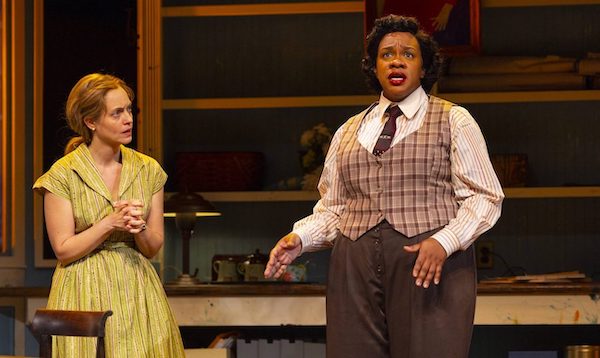
Stacy Fischer and Breezy Leigh in The Huntington’s production of Taylor Mac’s Joy & Pandemic. Photo: T Charles Erickson
By Robert Israel
When the curtain rises on act one of Taylor Mac’s ambitious but ultimately weighty and unsatisfying play, many in the audience the night I attended audibly gasped; several applauded. The scenic design by Arnulfo Maldonado is truly a “joy” to behold. Depicting an art school in Philadelphia in 1918, the room is cluttered with easels and drawings, vases and flowers; a noisy set of chimes trumpets the arrival of the cast of five who sashays across this room, resplendently dressed in period costumes brilliantly designed by Sarita Fellows. At first I thought I might be attending the repertory company’s production of one of Oscar Wilde’s taut comedies of manners, what with all the broad-brimmed ladies’ hats held in place by menacing hatpins. It seemed that the audience was anticipating this, too, thanks to an initial homage to Wilde in the script’s early banters. But that mood fizzles. Soon, in spite of the radiant set and colorful fabrics, darkness prevails.
That’s because — even in this most historic of American cities where a parade is underway commemorating the end of World War I– all the characters are fraught with worry over the influenza pandemic, now raging. We are meant to make the (unspoken) connection to our own collective struggle with the Covid pandemic over the past few years. This threatening reality forces the characters to cave in under the weight of ponderous issues that include internecine family conflicts, religion, racism, privilege, among others.
Those conflicts center on the title character, Joy Eldridge (Stacy Fischer), a Christian Scientist and director of the art school which caters to (mostly) white children of privilege. Not unlike the anti-vaxxers among us during Covid, Joy believes her faith will see through the influenza pandemic. It is symptomatic of a collective denial we all know too well. (It resonated with my memory of Robyn Twitchell, a two year-old who died of a bowel obstruction in Hyde Park in 1986 despite repeated attempts by a Christian Science practitioner to heal him through prayer.) We hear “the world is larger than us – you don’t need to be in charge of it.” We also hear that the pandemic is “a lie we tell ourselves.” The problem is that corpses don’t lie: they just pile up. Yes, many of these deaths could have been prevented. Prayerful attempts at healing rarely trump an application of legitimate science and pharmaceutical intervention.
The plot revolves around whether it is time to carry on business as usual. Rosemary (Marceline Hugot) insists that Joy’s husband (and Rosemary’s son) Bradford (Ryan Winkles) and daughter Pilly (Ella Dershowitz) hold off on the open house they are busily preparing for. The racial conflict is subtly underscored when Bradford puts finishing brush strokes on the only Black student’s painting – it can’t be possibly be good enough without his interference.
That racial theme is picked up in the second act, set in 1952, during the polio pandemic. We meet Marjory (Breezy Leigh), who returns to the art school and gazes upon her painting made when she was a youngster. She puts her own finishing touches on the canvas. That act of completing her work of art – it represents the unfinished canvas of her life – is the only uplifting moment in an otherwise lugubrious script.
While HTC director Lorretta Greco is, to use her words, “over the moon” about playwright Mac, I was less impressed. I have not seen his other works, for which he has been lauded with a Tony nomination and critical acclaim. I don’t doubt that he is gifted, as evidenced by being awarded a MacArthur “genius” grant. And, indeed, he may be “a relentless and loving instigator” (again, Greco’s words). But I did not see evidence of that here, where Mac’s characters spend an inordinate amount of time telling us what they think and feel. Homage is paid to the “mystery” of art — but there’s not much evidence of it over the play’s two-hour duration. I did see a talented cast doing its best to add buoyancy to a script weighted down in palaver.
**
A previous version of this review was published in The Arts Fuse magazine, May 6th, 2023.
